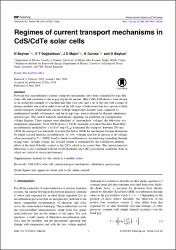| dc.contributor.author | Bayhan, Habibe | |
| dc.contributor.author | Dağkaldiran, E. T. | |
| dc.contributor.author | Major, J. D. | |
| dc.contributor.author | Durose, K. | |
| dc.contributor.author | Bayhan, Murat | |
| dc.date.accessioned | 2020-11-20T14:41:46Z | |
| dc.date.available | 2020-11-20T14:41:46Z | |
| dc.date.issued | 2019 | |
| dc.identifier.issn | 0268-1242 | |
| dc.identifier.issn | 1361-6641 | |
| dc.identifier.uri | https://doi.org/10.1088/1361-6641/ab23b5 | |
| dc.identifier.uri | https://hdl.handle.net/20.500.12809/977 | |
| dc.description | Major, Jonathan/0000-0002-5554-1985 | en_US |
| dc.description | WOS: 000471319500008 | en_US |
| dc.description.abstract | Forward bias recombination (current transport) mechanisms have been evaluated for thin film solar cells and correlated to the in-gap trap levels present. Here CdTe/CdS devices were chosen as an archetypal example of a modern thin film solar cell, and a set of devices with a range of design variables was used in order to reveal the full range of behaviours that may operate to limit current transport. Experimental current-voltage-temperature datasets were compared to mathematical models of transport, and the in-gap traps were evaluated by thermal admittance spectroscopy. The current transport mechanisms operating are presented on a temperature-voltage diagram. Three regimes were identified: at 'intermediate' voltages, the behaviour was temperature dependent. From 300 K down to 240 K, thermally activated Shockley Read Hall recombination mediated by a 0.38 eV trap (V-Cd) dominated the transport. Between 200 and 240 K the transport was thermally activated but below 200 K the mechanism became dominated by tunnel assisted interface recombination. At 'low' voltages (and for all devices at all voltages when measured at T < 200 K) band to band recombination is via multi-step tunnelling through in-gap states. At high voltage, the forward current is dominated by the well-known limiting effect of the back Schottky contact to the CdTe which is in reverse bias. The current transport behaviour is also correlated with the n-CdS thickness and CdCl2 processing conditions, both of which are critical to device performance. | en_US |
| dc.description.sponsorship | EPSRCEngineering & Physical Sciences Research Council (EPSRC) [EP/P02484X/1, EP/K005901/1] | en_US |
| dc.description.sponsorship | The authors acknowledge part funding through EPSRC grants EP/P02484X/1 and EP/K005901/1 | en_US |
| dc.item-language.iso | eng | en_US |
| dc.publisher | Iop Publishing Ltd | en_US |
| dc.item-rights | info:eu-repo/semantics/openAccess | en_US |
| dc.subject | Cds/Cdte Solar Cell | en_US |
| dc.subject | Current Transport Mechanisms | en_US |
| dc.subject | Admittance Spectroscopy | en_US |
| dc.title | Regimes of current transport mechanisms in CdS/CdTe solar cells | en_US |
| dc.item-type | article | en_US |
| dc.contributor.department | MÜ, Fen Fakültesi, Fizik Bölümü | en_US |
| dc.contributor.institutionauthor | Bayhan, Habibe | |
| dc.identifier.doi | 10.1088/1361-6641/ab23b5 | |
| dc.identifier.volume | 34 | en_US |
| dc.identifier.issue | 7 | en_US |
| dc.relation.journal | Semiconductor Science and Technology | en_US |
| dc.relation.publicationcategory | Makale - Uluslararası Hakemli Dergi - Kurum Öğretim Elemanı | en_US |


















